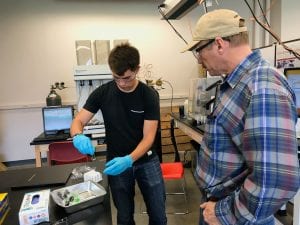By: Tiffany Acosta
 |
|
| 09/12/2018: Elijah Wade (left), New Mexico State University chemical engineering graduate student, prepares samples to test in NMSU’s Freeport-McMoRan Water Quality Laboratory with Mark Chidester, the lab coordinator. The lab, located in the Ed and Harold Foreman Engineering Complex III, helps professors and students conduct valuable research. (NMSU photo by Tiffany Acosta) | |
|
|
Since the Freeport-McMoRan Water Quality Laboratory was established in 2009 in New Mexico State University’s College of Engineering, the facility has been a critical resource for NMSU professors and students.
The facility is a full-service analytical laboratory located in the Ed and Harold Foreman Engineering Complex III. Currently, the lab has 10 analytical instruments that are equipped to identify the chemical and colloidal characteristics of a water/particle system.
Mark Chidester, lab coordinator, said the ion chromatography system, which measures the concentration of individual anions or cations in water; total organic carbon and total nitrogen analyser, which measures total organic carbon and total nitrogen in water samples; inductively coupled plasma-mass spectrometer, which measures metal concentrations in water; and thermogravimetric analyzer, which measures weight changes with temperature increase up to 1,000 degrees Celsius, are presently the most used instruments in the facility.
“We are currently using the lab for our NSF (National Science Foundation)-funded Center for Biomediated and Bioinspired Geotechnics Engineering Research Center, a multi-million, multi-year, multi-institution project,” said Lambis Papelis, associate professor of environmental engineering in the civil engineering department, who has used the lab since he arrived at NMSU in 2010.
“Previously, we have used it for other NSF-, NMDOT- (New Mexico Department of Transportation) or NMSU-funded projects,” he added. “The current project deals with the development of a modified zeolite system for the remediation of groundwaters contaminated with toxic anions, such as arsenic. The type of work I’m doing at NMSU would have been impossible without the Freeport-McMoRan lab.”
Pei Xu, environmental engineering associate professor, reiterates the significance of the lab to research at NMSU.
“It is absolutely critical to my research. Without this lab, I would not be able to analyze the removal of contaminants and ensure the water quality during water treatment, wastewater reuse and desalination,” she said.
“All my research projects and graduate students are supported by this lab, including my current 11 projects funded by NSF, DOE, Bureau of Reclamation, NASA and water industry,” Xu said.
Catherine Brewer, chemical and materials engineering assistant professor, uses the lab for sample preparation and analyses for research projects on hydrothermal liquefaction of algae grown on municipal wastewater, which is NSF and Bureau of Reclamation funded; adsorption of N-nitrosodimethylamine on wood waste/pecan shell-derived carbon, which is NASA-funded; adsorption of uranium and heavy metals on carbons, which is an internally funded mini-grant; and growth of hybrid poplar on biochar-amended soil, which is USDA-funded.
“We use the lab for several key characterization analyses needed to describe the products of our reaction optimization and adsorption experiments, and to track changes in soil and plant characteristics over the growth season,” Brewer said. “In several cases, the lab has equipment and capabilities that are only found in one or two places on campus; without the capabilities of the lab, we would have to send the samples out for external analysis, costing more and lessening the amount of experience that student researchers gain from analyzing their own samples.”
The facility also houses a high performance liquid chromatography system, which measures the concentration of organic compounds in water; gas chromatograph-mass spectrometer, which measures and identifies volatile and semi-volatile organic compounds in liquids; Malvern Zetasizer Nano ZS, which measures zeta potential and size of suspended particles; surpass electrokinetic analyzer, which measures zeta potentials of membranes, granules or fiber particles; microwave digester, which is for dissolving solids into acidic water for future metal analysis; and extended adsorption analyzer, which measures the surface area and porosity of solids.
For more information on the lab visit https://wordpress.nmsu.edu/mchidest/freeport-mcmoran-water-quality-lab/.
